Introduction
Managing our soils to optimize physical, chemical, and biological properties can increase soil health and function, along with improving productivity and sustainability of our cropping systems. Current soil health tests have been developed and evaluated based on their direct or indirect relationship with soil functions1. In other words, soil health tests are an indicator of broader functions occurring within the soil. Soil characteristics such as good aggregation and structure, water infiltration rate and storage capacity, high biodiversity and nutrient cycling ability are often associated with good soil health.
Ultimately, the reasons for why you might conduct a soil health test are dependent upon your goals on the farm and what you are trying to accomplish in terms of soil management. Here, we present some foundational considerations related to soil health testing and describe situations where soil health testing can provide useful information about specific soil functions to farmers, landowners, agronomists, and crop consultants.
Use-Cases for Soil Health Testing
Guiding Future Management
This use-case for soil health testing likely provides the most value to farmers. Research has shown that several commonly used soil health tests often respond positively to practice changes such as reduced tillage, cover crops, and diversified rotations2. Although this may be true, keep in mind that the rate at which soil health test values change following changes in management vary and are highly dependent upon climate and soil type. Figure 1 below illustrates an example of how to consider using soil health metrics for the purpose of guiding future management changes and tracking progress over time.
First, it is important to 1. collect baseline soil samples and get them analyzed using desired soil health tests, so we know what the status of the farm is today. Baseline results can be contextualized by comparing them to established soil health benchmarks or with neighboring farms. With baseline and contextual knowledge, and with your soil health goals (e.g. building soil structure, water holding capacity, or biological activity) in mind, 2. decisions can then be made about what practice or 3. practices might be implemented to improve soil health and function (for example, reducing or eliminating tillage, incorporating cover crops, adding a small grain to the crop rotation, etc.).
Generally, soil health metrics tend to show a change after 3 to 5 years of implementing soil health management practices on the farm, at which point the 4. monitoring phase begins. Samples can be collected and analyzed to determine if the soil is responding to the management changes. Lastly, 5. adjustments to management can be made to continue to push the soil towards improved soil health. It is also valuable to compare results from one field to another or from one neighboring farm to another to help build local context and relative understanding of how different management impacts soil function.
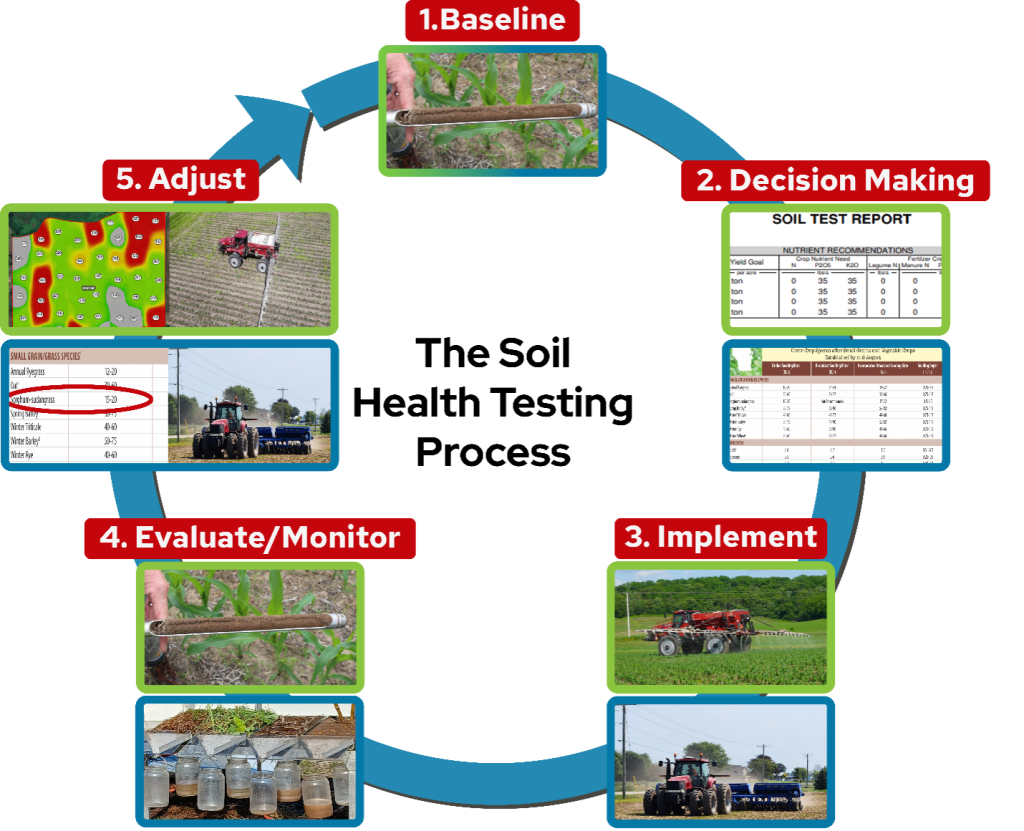
Figure 1. This illustration depicts how soil health tests and routine fertility tests share a similar framework to guide on-farm management decisions. At each step, colors outlining the boxes represent the action in the routine fertility framework (green) and soil health framework (blue). Click to enlarge.
- Baseline: Collect baseline soil samples for routine fertility and soil health indicator tests
- Decision Making
- Routine Fertility Framework Action: Decide nutrient application based on baseline test results.
- Soil Health Framework Action: Choose cover crop species and seeding rates.
- Implement
- Routine Fertility Framework Action: Apply nutrients based on soil test results.
- Soil Health Framework Action: Seed cover crops.
- Evaluate and Monitor
- Routine Fertility Framework Action: Collect new soil samples 3-4 years after implementing fertility plan.
- Soil Health Framework Action: Collect new soil samples and assess in-field changes in soil function (e.g., runoff/infiltration tests)
- Adjust
- Routine Fertility Framework Action: Adjust nutrient application rates based on new soil test results.
- Soil Health Framework Action: Adjust cover crop species or incorporate different species into the mix to achieve additional soil health benefits.
Tracking over time while maintaining the status quo
Some farmers have a general curiosity about what is happening related to soil health on their farms. They may not necessarily want to compare notes with other farmers or be ready to make any management changes on their farm, but they want to know the baseline status of their soils.
Over time, soil health testing can provide insight as to how soil functions may, or may not, be changing while operating “business as usual.” If soil health metrics start trending in one direction or another, it can lead a farmer to do a little more digging to determine what might be causing the changes.
How does my soil compare to my neighbor’s soil?
For some, understanding how their farms’ soil health compares to their neighbors is of high value. In other words, being able to relate various soil health metrics from one specific farm to other farms around the state that are managed under similar cropping systems on similar soil types would provide context to the metrics themselves.
Similarly, understanding how soil health metrics vary between cropping systems and across soil types would provide additional insight into what soil health changes might be realistic under any given circumstance. Of course, neighboring farms or groups of farms within some geographically defined area (producer-led watershed groups, for example) could compare notes together.
Soil Health Testing vs. Soil Fertility Testing
Traditional soil fertility testing and soil health testing involve similar processes, but the resulting decisions and actions based on the results differ. Broadly stated, soil fertility management on the farm begins with collecting representative soil samples3 and having them tested for 1. baseline fertility status. Evaluating the soil fertility test results allows us to 2. make decisions about which nutrients need applying, and at what rates they should be applied to optimize profitable crop production.
Generally, following 2 to 4 years of 3. implementing a fertility and crop plan, routine fertility testing is repeated to 4. evaluate how soil test levels have changed. If soil test levels aren’t building-up, maintaining, or drawing-down as intended, 5. adjustments to the fertility and cropping system plan can be made to “move the needle” in the right direction.
Routine fertility soil tests have been researched in Wisconsin for 50+ years and have been correlated to crop yield, providing the scientific basis for fertilizer and lime recommendations. An example of phosphorus application rate recommendations based on soil test levels (Figure 2) and a visual explanation of what common soil test interpretation categories mean can be found in Figure 3.
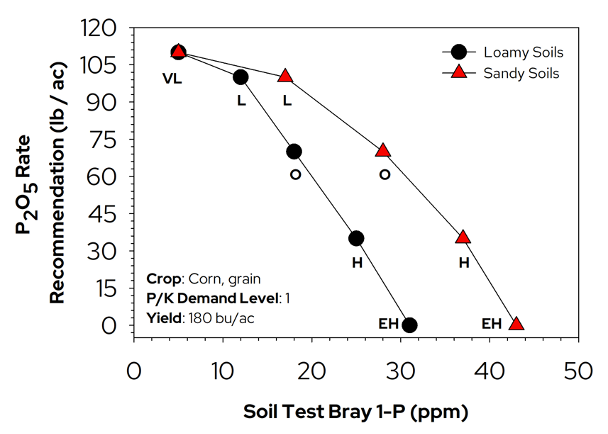
Figure 2. An illustration of P2O5 fertilizer rate recommendations decreasing as soil test phosphorus levels increase. This data is based on field correlation and calibration research in Wisconsin, as documented in UW-Extension Publication A2809. (Soil test interpretation categories: VL – Very Low; L – Low; O – Optimum; H – High; EH – Excessively High). Note that soil test interpretation categories (e.g. VL, L, O, etc.) are different depending on soil type (loamy vs sandy soils). Click to enlarge.
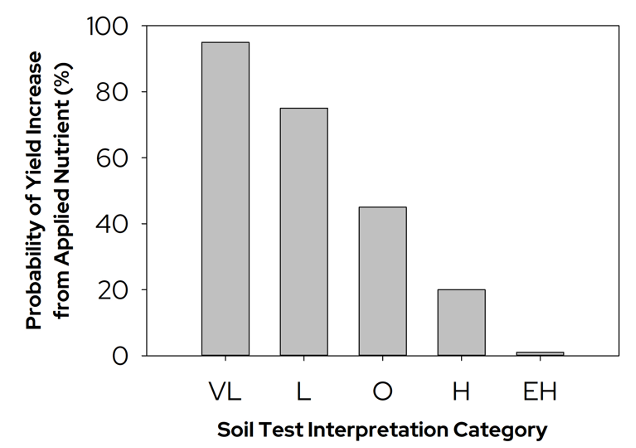
Figure 3. Soil test interpretation categories are delineated based on the relative probability of an observed yield response occurring from additional applied nutrients. Here, it is evident that as soil test levels increase (VL to EH), the probability of a yield response to an added nutrient decreases significantly. Click to enlarge.
Can we use soil health indicators to predict yield or fertilizer needs?
The farming community in Wisconsin is eager to understand how soil health tests can help predict factors like crop yield, soil nutrient cycling, and optimal fertilizer rates. Unlike routine fertility tests, the links between soil health metrics and agronomic outcomes are not well understood. As of 2025, soil health tests are not designed (or calibrated) to predict crop yields or specific nutrient needs in Wisconsin.
Some research in Wisconsin and the Midwest has explored connections between soil health tests and crop yield4,5, as well as the potential for these tests to determine optimal nitrogen fertilizer rates for corn grain6,7. However, these relationships are more complex than for traditional fertility tests (e.g. the relationship between soil test potassium and corn yield).
To make soil health tests reliable tools for predicting agronomic outcomes, more data is needed to clarify these relationships and to assess their utility and reliability. The UW–Madison soil health team is actively conducting research in this area.
Conclusion
Soil health testing can be a valuable tool in the toolbox for farmers that can help us measure the path towards enhanced soil function and sustainable cropping systems in Wisconsin. Knowing how the soil health of your farm’s soils is changing over time and comparing your values to farms in your region can aid in conservation and soil health management practices.
Using soil health testing to quantify and track changes in soil function requires knowledge of where measurements are today and how they respond to changes in field management practices with respect to soil type. At the current moment, there are no management decisions explicitly connected to soil health testing; instead, we encourage farmers, agronomists, and consultants to use soil health testing for their own field-based decision making.
For more in-depth reading, check out resources that were cited throughout the article below.
Resources
- Dianna K. Bagnall, Elizabeth L. Rieke, Cristine L.S. Morgan, Daniel L. Liptzin, Shannon B. Cappellazzi, C. Wayne Honeycutt. 2023. A minimum suite of soil health indicators for North American agriculture. https://doi.org/10.1016/j.soisec.2023.100084.
- Liptzen et al. 2022. An evaluation of carbon indicators of soil health in long-term agricultural experiments. https://doi.org/10.1016/j.soilbio.2022.108708.
- Peters and Laboski, Sampling Soils for Testing A2100. https://learningstore.extension.wisc.edu/products/sampling-soils-for-testing-p183
- Oldfield et al., 2022. Positive associations of soil organic matter and crop yields across a regional network of working farms. https://doi.org/10.1002/saj2.20349
- Malone et al., 2023. Linking soil health indicators to management history and soybean yield. https://doi.org/10.1016/j.fcr.2023.108951
- Bean et al., 2020. Relating four-day soil respiration to corn nitrogen fertilizer needs across 49 U.S. Midwest fields. https://doi.org/10.1002/saj2.20091
- Yost et al., 2018. Evaluation of the Haney Soil Health Tool for corn nitrogen recommendations across eight Midwest states. 10.2489/jswc.73.5.587
Updated: April 30, 2025
Reviewed by: Dr. Erin Silva, Dr. Damon Smith, Dr. Francisco Arriaga

 Soil Health in Cranberry Production Systems: A Case Study of Four Wisconsin Farms
Soil Health in Cranberry Production Systems: A Case Study of Four Wisconsin Farms ▶ Unlocking the Potential of Biological Nitrogen Fixation in Corn
▶ Unlocking the Potential of Biological Nitrogen Fixation in Corn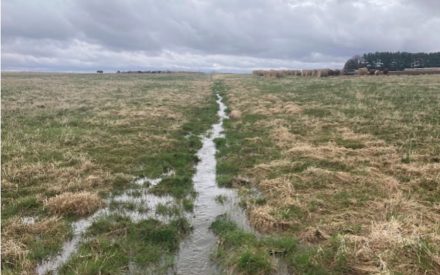 ▶ Nitrogen Leaching: Trends, Risks and Regional Insights
▶ Nitrogen Leaching: Trends, Risks and Regional Insights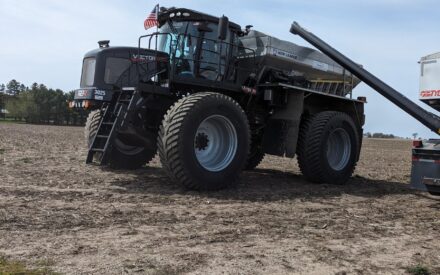 ▶ What You Can and Can’t Learn from a Nitrogen Response Curve
▶ What You Can and Can’t Learn from a Nitrogen Response Curve


